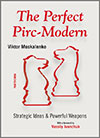
The
Perfect Pirc - Modern by Viktor Moskalenko
2013
New in Chess
http://www.newinchess.com/
255 pages
Price € 24,95
ISBN:
978-90-569-14-028
Viktor Moskalenko explains at the hand of 37 model games the secrets
and strategies of the Pirc and Modern Defence.
For example in the Austrian Attack Moskalenko prefers the set-up with
moves as: 1.e4 d6 2.d4 Nf6 3.Nc3 g6 4.f4 Bg7 5.Nf3 c5 6.Bb5+ Bd7
7.e5 Ng4 8.e6 fxe6 9.Ng5 Bxb5 10.Nxe6 Bxd4 11.Nxb5 Qa5+ 12.Qd2 Qxd2+
13.Bxd2 Kd7 14.Nbxd4 cxd4 15.Nxd4 Rc8 16.0-0 Rc5
17.c3 Nc6 18.Nf3 b5 and now 19.a4 bxa4 20.Rxa4 Rb8 21.b4 Rc4 with a
unclear position Grischuk.
Other sharp lines in this exciting read are for example The Dynamic
Bishop Attack 1.e4 d6 2.d4 Nf6 3.Nc3 g6 4.Bg5 Bg7 5.f4 h6 6.Bh4 c5
7.e5 Nh5 8.dxc5 Nxf4 9.exd6 g5 10.Bg3 Qa5 11.Qd2 Qxc5 12.0-0-0 and now
12…Bxc3!? 13.Qxc3 Qxc3 14.bxc3 Nc6 and it seems that black is still
alive.
Interesting are Moskalenko words on the Summary of the Classical
Sämisch:
1.e4 g6 2.d4 Bg7 3.Nc3 d6 4.Be3 a6.Since the appearance of Tiger’s
Modern in 2005,Black’s set-up with …a6 has become more and
more popular up to a certain level {Grischuk and Ponomariov used it in
the Modern order,and Kramnik in the Normal Pirc}.
However,I have not found any recent game played by the author!
The fact is that Swedish grandmaster Tillarp person has changed his
Pirc-Modern repertoire and has started playing more
and more in Classical style,with …c7-c6.
Going throw this book you will find a lot of latest 2012 material and
that makes this book much more interesting that the latest work from
James Vigus on The Pirc.
Conclusion: This is a very important
reference work on the Pirc-Modern Defence!
 The French Winawer:
Move by Move by Steve Giddins
2013
Everyman
Chess
The French Winawer:
Move by Move by Steve Giddins
2013
Everyman
Chess
http://www.everymanchess.com
400 pages
Price € 25,95
ISBN 978-1-85744-991-4
Seldom I have seen a book on the French that describes so instructively
the techniques of the Positional French Main Line,as we for example can
see
can see in the following model game from Kortschnoj who understood more
about it than any other player of it's time.
Van Seters,Frits - Kortschnoj,Viktor (2640) [C19]
Skopje ol (Men) qual-A Skopje (1), 19.09.1972
1.e4 e6 2.d4 d5 3.Nc3 Bb4 4.e5 c5 5.a3 Bxc3+ 6.bxc3 Ne7 7.Nf3 Bd7 8.a4
Qa5 9.Bd2 Nbc6 10.Be2 c4 11.0-0 f6 12.Re1 0-0
13.exf6 Rxf6 14.Bg5 Rf7 15.Qd2 Raf8 16.Bh4 Nf5 17.Bg3 h6 18.Rad1 Qd8
19.Rb1 Bc8 20.Qc1 g5 21.Ne5 Nxg3 22.fxg3 Nxe5
23.dxe5 Qa5 24.Qe3 b6 25.Bh5 Rf2 26.Rf1 Rxf1+ 27.Rxf1 Qc5 28.Qxc5 Rxf1+
29.Kxf1 bxc5 30.a5 Bd7 31.Ke2 Kf8 32.h4 Be8 33.Bg4 Ke7 34.hxg5 hxg5
35.Kd2 Kd7 36.Kc1 Bf7 37.Kb2 Kc6 38.Ka3 Kb5 39.Kb2 Kxa5 40.Ka3 Kb5
41.Kb2 a5 0-1.
Steve Giddins writes about the move 8.a4:Actually,this is one of the
two main approaches for white, in this position. As we noted
above, a key element in white’s strategy is to activate his unopposed
dark-squared bishop, and the most obvious place
to put it is a3,from
where it will bear down the a3-f8 diagonal, cutting through the heart
of black’s position. The text immediately sets about trying to do that.
Some players as Neil McDonald see it different he wrote about the move
a4 in his book the French Winawer:I have always been rather
puzzled as to the reason of this move.In books on the French it is
confidently stated that that idea to clear the way for the development
of
the queen’s bishop to an active diagonal on a3.Perhaps,but after black
plays …Qa5 the bishop almost goes to d2 instead!
Viktor Moskalenko considers in his great work on The Wonderful Winawer
writes about a4”Of course this move cannot be the best option
for white but the concept behind it is easy to understand.”
But the great Bobby Fischer who understood more about chess than
anybody else of his time went for a4 and he lost!
Fischer,Robert James - Uhlmann,Wolfgang [C19]
150 years of Argentina Buenos Aires (8), 02.07.1960
1.e4 e6 2.d4 d5 3.Nc3 Bb4 4.e5 Ne7 5.a3 Bxc3+ 6.bxc3 c5 7.a4 Nbc6 8.Nf3
Bd7 9.Qd2 Qa5 10.Bd3 c4 11.Be2 f6 12.Ba3 Ng6
13.0-0 0-0-0 14.Bd6 Nce7 15.Nh4 Rde8 16.Nxg6 hxg6 17.exf6 gxf6 18.h3
Nf5 19.Bh2 g5 20.f4 Nd6 21.Bf3 g4 22.hxg4 f5
23.g5 Re7 24.Bg3 Be8 25.Qe3 Ne4 26.Bxe4 dxe4 27.Kf2 Reh7 28.Rfb1 Qd5
29.Qe1 Rh1 30.Qxh1 e3+ 31.Kg1 Rxh1+
32.Kxh1 e2 33.Rb5 Bxb5 34.axb5 Qxb5 35.Re1 a5 36.Rxe2 a4 37.Rxe6 a3
38.g6 Qd7 39.Re5 b6 40.Bh4 a2 41.Re1 Qg7
42.Ra1 Qxg6 0-1,this is one of the great Winawer games,thanks to
Uhlmann’s brilliant strategic idea at move 21.
You shall also find in this book a excellent coverage of the
Tactical mainline with 7.Qg4,included with the interesting 1.e4 e6 2.d4
d5
3.Nc3 Bb4 4.e5 Ne7 5.a3 Bxc3+ 6.bxc3 c5 7.Qg4 cxd4 8.Qxg7 Rg8 9.Qxh7
Qc7 10.Ne2 Nbc6 11.f4 dxc3 12.Qd3 d4!?.
Conclusion: Super instructive!
 Fighting Chess move by
move by Colin Crouch
2013
Everyman
Chess
Fighting Chess move by
move by Colin Crouch
2013
Everyman
Chess
http://www.everymanchess.com
296 pages
Price € 23,75
ISBN 978-1-85744-993-8
Colin Crouch reveals in this book a collection of 27 best played games
of the year 2012 and has analysed them with move to move
annotations
into a painstaking depth.
This game collection is more than a coverage of key strategic aspects
no Crouch puts all the moves under the microscope!
All games come from the best players of the world and it includes all
the six games of the Kramnik – Levon Match from Zurich 2012,all twelve
games of the World Championship match between Anand and
Gelfand,Moscow 2012,and six games of Tal nenorial and that includes the
fascinating endgame between Radjabov and Carlsen: Radjabov,Teimour
(2784) - Carlsen,Magnus (2835) [C45]
Moscow Tal Memorial 7th Moscow (5), 13.06.2012
1.e4 e5 2.Nf3 Nc6 3.d4 exd4 4.Nxd4 Bc5 5.Nxc6 Qf6 6.Qf3 bxc6 7.Qg3 d6
8.Nc3 Qg6 9.Bd3 Nf6 10.Na4 Bd4
11.c3 Bb6 12.0-0 Qxg3 13.hxg3 Ng4 14.Bf4 f6 15.Rad1 h5 16.Be2 Be6
17.Nxb6 axb6 18.a3 Ke7 19.f3 Ne5 20.Kf2 b5
21.Bxe5 fxe5 22.Ke3 h4 23.gxh4 Rxh4 24.Rh1 Rah8 25.Rxh4 Rxh4
26.Rc1 Rh2 27.Kf2 Rh8 28.Ke3 g5 29.Bd3 Kd7
30.Ra1 Bb3 31.Rc1 Kc8 32.Kf2 Kb7 33.Kg3 Be6 34.Ra1 Kb6 35.Rc1 c5 36.Ra1
c4 37.Bc2 Kc5 38.Re1 c6 39.Bb1 Kb6
40.Bc2 Kc7 41.Kf2 Kd7 42.a4 bxa4 43.Ra1 Rb8 44.Ra2 d5 45.exd5 cxd5
46.Bxa4+ Kd6 47.Bc2 d4 48.Be4 Rb6 49.Ke2 g4
50.fxg4 Bxg4+ 51.Kd2 Be6 52.Kc2 Bd5 53.Bxd5 d3+ 54.Kd2 Kxd5 55.Ke3 Rg6
56.Ra5+ Ke6 57.Ke4 Rg4+ 58.Kf3 Rf4+
59.Ke3 Rf1 0-1,yes Magnus played in Capablanca's footsteps and this
game is good for nearly 14 pages of text.
Conclusion: One of those super reads!
Angrffslektionen 1 by
Jacob Aagaard
2013
Quality Chess
336pages
Price €24,99
ISBN 978-3-942383-73-8
Angrffslektionen
2 by Jacob Aagaard
2013
Quality Chess
480 pages
Price €24,99
ISBN 978-3-942383-74-5
I am pleased to mention these two new translations from Jacob
Aagaard into the German language, Aagaard has written a Hugh
amount of
chess books but these two belong to his absolute best.
Both manuals handle the techniques of attack, in part one you shall
find some of the finest attacks and part two digs more in the fine
techniques of attacks, again with a lot of instructive games, exercises
and more.
Aagaard has the talent of explanation but he also expects for success
some digging from the chess student.
The German reader will certainly enjoy the lines from the odd gambit
magazine Rand Springer where Aagaard has included the
game Sephan Ziska – Manfred Herbold,Email 2001:
1.e4 e6 2.d4 b5 3.Bxb5 Bb7 4.Nc3 Bb4 5.f3 Qh4+ 6.Kf1 Ne7 7.Nh3 0-0
8.Be2 h6 9.Nb5 f5 10.exf5 Nxf5 11.c3 Ba5
12.Na3 Bb6 13.Nc4 Nc6 14.Qe1 Qh5 15.Bf4 g5 16.Bd2 Ncxd4 17.cxd4 Nxd4
18.Nxb6 Bxf3 19.Bxf3 Nxf3
20.Qd1 Nxd2+ 21.Ke1 Qh4+ 22.Kxd2 axb6 23.Qe2 Qb4+ 24.Kc1 Qc5+ 25.Qc2 g4
26.Qxc5 bxc5 27.Rg1 gxh3
28.gxh3+ Kf7 29.Kd2 d5 30.a4 Ke7 31.Ke2 c4 32.Ke3 Rab8 33.Ra2 Rb3+
34.Ke2 Rfb8 35.Rga1 Rxh3 36.Rh1 Rhb3 37.Rb1 c3 38.Kd3 c5 39.Kc2 0-1,and
good for nearly 5 pages of text!
Not include in these two works a game index and that is
quite pity!
Conclusion: Certainly two must have
learning books!
Grandmaster Repertoire
13
The Open Spanish
by Victor Mikhalevski
2013
Quality Chess
380 pages
Price €24,99
ISBN 978-1-907982-44-6
Grandmaster Victor Mikhalevski provides the black player with a
detailed move to move repertoire book based on the Open Spanish 1.e4 e5
2.Nf3 Nc6
3.Bb5 a6 4.Ba4 Nf6 5.0–0 Nxe4.
The soul of this book,the Main Line goes to the pawn push with 1.e4 e5
2.Nf3 Nc6 3.Bb5 a6 4.Ba4 Nf6 5.0-0 Nxe4 6.d4 b5 7.Bb3 d5 8.dxe5 Be6
9.Nbd2 Nc5 10.c3 Be7 11.Bc2 d4!?
In Chess Publishing.com they wrote after 11…d4 It is difficult to know
how to annotate this move. On the one hand it can't be criticised
because it is
the main line and has been played by many strong GMs including
Kortchnoi himself - one of the greatest experts in the Open Variation.
However, it
seems to me that it defeats the purpose of the open - which is to
achieve a game rich in complexity and piece play - because with 12.Nb3
White can
now force the game into a dull endgame that only he can win!
But Mikhalevski gives: 1.e4 e5 2.Nf3 Nc6 3.Bb5 a6 4.Ba4 Nf6 5.0-0 Nxe4
6.d4 b5 7.Bb3 d5 8.dxe5 Be6 9.Nbd2 Be7 10.c3 Nc5 11.Bc2 d4
12.Nb3 d3 13.Bb1 Nxb3 14.axb3 Bf5 15.Be3 0-0 16.Bd4 Qd5 17.Re1 d2
18.Re2 Bxb1 19.Rxb1 Nxd4 20.Nxd4 Bg5 21.g3 c5 22.Nf5 Qd3
23.Nd6 Qg6 24.h4 Bxh4 25.Rxd2 Be7 and now 26.Ra1!?N and writes This new
move seems to be white’s best chance for a meaningful advantage.
And after 26…f6! 17.Qf3 fxe5 28.Qd5+ Kh8 29.Qe5 Bg5!? Follows nearly 3
pages of analyses where it seems that it all ends in a draw!
A lot of these moves are subtle and memorizing, maybe it is for the
reader a good idea to concentrate on typical plans
and manoeuvres.
A large amount of pages 339 in this book are divided to various
alternatives as
1.e4 e5 2.Nf3 Nc6 3.Bb5 a6 4.Ba4 Nf6 5.Bxc6 dxc6 6.d3 Bd6 and a lot of
side lines where white avoids the main lines.
This is all clearly covered with well thought repertoire moves!
Conclusion: With this book you can
truly outplay your opponent!
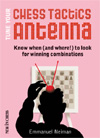 Tune Your Chess
Tactics Antenna
Tune Your Chess
Tactics Antenna
Know when (and where!) to look for
winning combinations
by Emmanuel Neiman
2013
New in Chess
http://www.newinchess.com/
237 pages
Price € 24,95
ISBN:
978-90-569-1404-2
Emmanuel Neiman presents the reader a revolutionary method of chess
thinking based on the weaknesses of the opponent’s position.
The pattern of recognizing is packed in his seven signals: King
Position, Unprotected Pieces, Alignment,Knight Fork Distance, Trapped
Pieces, Crucial Defender/Overloaded Defender and Important
Defence/Defence too far away.
It is pleasant to see a classic beauty packed in this modern
jacket, chapter 8 King Positions: Nimzowitsch,Aaron - Tarrasch,Siegbert
[D05]
St Petersburg preliminary St Petersburg (5), 28.04.1914
1.d4 d5 2.Nf3 c5 3.c4 e6 4.e3 Nf6 5.Bd3 Nc6 6.0-0 Bd6 7.b3 0-0 8.Bb2 b6
9.Nbd2 Bb7 10.Rc1 Qe7 11.cxd5 exd5 12.Nh4 g6
13.Nhf3 Rad8 14.dxc5 bxc5 15.Bb5 Ne4 16.Bxc6 Bxc6 17.Qc2 Nxd2 18.Nxd2
d4 19.exd4 Bxh2+ 20.Kxh2 Qh4+ 21.Kg1 Bxg2
22.f3 Rfe8 23.Ne4 Qh1+ 24.Kf2 Bxf1 25.d5 f5 26.Qc3 Qg2+ 27.Ke3 Rxe4+
28.fxe4 f4+ 29.Kxf4 Rf8+ 30.Ke5 Qh2+ 31.Ke6 Re8+ 32.Kd7 Bb5# 0-1,
Tarrasch was congratulated after this game but he declared he had no
merit, because the winning method had already been discovered by Lasker
back in 1889.
Include throw the book are several techniques as Zugzwang where I found
the following game from Botvinnik: Ilyin Zhenevsky,Alexander -
Botvinnik,Mikhail [C90]
URS-ch sf Leningrad, 1938
1.e4 e5 2.Nf3 Nc6 3.Bb5 a6 4.Ba4 Nf6 5.0-0 Be7 6.Re1 b5 7.Bb3 d6 8.c3
0-0 9.d3 Na5 10.Bc2 c5 11.Nbd2 Re8 12.Nf1 Bf8
13.Bg5 h6 14.Bh4 Nc6 15.Ne3 Be7 16.d4 cxd4 17.cxd4 Nh7 18.Bg3 Ng5
19.dxe5 Nxf3+ 20.Qxf3 dxe5 21.Bb3 Be6 22.Bxe6 fxe6
23.Red1 Qb6 24.Qh5 Bg5 25.Ng4 Qc7 26.Rd3 Kh7 27.Rad1 Red8 28.Nxe5 Nxe5
29.Bxe5 Qb7 30.Qg4 Rxd3 31.Rxd3 Rd8
32.Rxd8 Bxd8 33.h4 Qf7 34.f4 Bf6 35.Bxf6 Qxf6 36.e5 Qd8 37.Kh2 Qd5
38.a3 Kg8 39.h5 a5 40.Kh3 Qb3+ 41.Kh4 Kf8
42.Qe2 b4 43.axb4 Qxb4 44.Kg4 Qb3 45.Qd2 Qb7 46.Kg3 Qb3+ 47.Kh2
Qc4 48.Kg3 Qb3+ 49.Kh2 Qc4 50.Kh3 Qb3+
51.Kh2 Qc4 52.Kg1 Ke8 53.Kh2 a4 54.Qf2 Qc1 55.Qd4 Qc2 56.Kg3 Qb3+
57.Kh2 a3 58.bxa3 Qxa3 59.Qc4 Qe7 60.Kh3 Qd7
61.f5 Ke7 62.Qg4 Qd3+ 63.Kh2 Qxf5 64.Qxf5 exf5 65.Kg3 Kf7 66.Kf4 g6
½-½.
As Neiman points out in this game 66.Kf3 was the winning move to come
to f4.
Included are a lot of exercises to see if you have learned from the
lessons.
Conclusion: seldom I have seen such a
instructive book!
 Mastering Complex
EndgamesPractical Lessons on Critical Ideas & Plans
Mastering Complex
EndgamesPractical Lessons on Critical Ideas & Plans
by Daniel Naroditsky
2013
New in Chess
http://www.newinchess.com/
237 pages
Price € 28,95
ISBN:
978-90-569-1405-9
Endgame books have the reputation of being boring and if we look at
books as, Secrets of Rook endings or Secrets of Pawn Less Endings
than we can understand that some say the endgame is the Cinderella of
chess.
James Howell wrote in his Essential Chess Endings” It doesn’t have the
glamour of a complicated middle game nor does it inspire the same
interest as the latest openings novelties”.
But quite different is this enjoyable read from the chess prodigy
Daniel Naroditsky {1995} who became the world champion under 12
champion in 2007.
This young man already impressed me back in 2010 with his book
Mastering Positional Chess and now this unbelievable read on endgames.
It is amassing to see how he brings highly complicated queen endgames
to life.
In some queen endings show us that concrete calculation can be combined
with subtle thinking to produce a great endgame display as we
could see in the game Ashley – De Firmian New York 1996,Or the epic
struggle Topalov Anand,San Luis 2005.
The material is brought into the following chapters: What are complex
endings, Rook Endgames, Rook + Minor
Pieces vs Rook + Minor Pieces,Queen Endgames, Queen + Minor Pieces vs
Queen + Minor Pieces and conclusion.
Included are exercises at the end of each chapter!
Conclusion: One of those readable
endgame books!
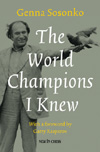 The World Champions I
Knew
The World Champions I
Knew
With a foreword by Garry Kasparov
by Genna Sosonko
2013
New in Chess
http://www.newinchess.com/
238 pages
Price € 24,95
ISBN:
978-90-569-1418-9
The bright Genna Sosonko describes in this book the portraits of
some of the great players of all time as Mikhail Tal,Tigran Petrosian
and Mihail Botvinnink.
Other great players that are portretted are Max Euwe,Vasily
Smyslov,Alexander Alekhine and Jose Raul Capablanca.
The reader will probably be surprised to see in the book the names
Capablanca and Alekhine but Sosonko writes:I’ll explain by immersing
myself in the émigré world of Russian paris of the ’20s
and ‘30s of the last century,which is completely unknown to the English
speaking reader,I studied the facts of Alekhine’s life after his flight
from Soviet Russia to such an extent that my feeling of personal
acquaintance with him seemed absolutely clear.
I can also say the same about Capablanca: after meeting in New York on
more than one occasion with his
widow,who was by birth,recalling the
years she spent by the side of the great champion, I somehow also felt
a connection of my own to the Cuban chess genius.
I knew Capa first appeared in Russian Silhouettes,The Proffesor first
appeared in the Reliable Past,A name as a Gunshot first appeared in
Dutch in Matten issue 8 and the other essays first appeared in New in
Chess.
Sosonko has the unique talent to create unbelievable atmospheres of
great chess players from today and yesterday where it is difficult to
say if it is pure chess journalistic or modern literature.
Conclusion:This book is a masterpiece
on chess writing!

English 1.c4 e5
for Black
by Viktor Bologan
2012
http://www.chessbase.com
E-Mail
info@chessbase.com
Euro 29,90
Pentium-Processor at 300 Mhz or higher, 64 MB RAM, Windows XP, Windows
Vista, Windows 7, DVD drive, mouse, soundcard.
The English Opening dates back to the times of the great Howard
Staunton and his friends when they started to begin there game with the
move 1.c4.
A great difference between 1.e4 and 1.c4 is the presence of enormous
transpositional possibilities as we can see in Bologan his latest DVD
on the
English Opening where the reader shall find a huge variety of reversed
forms of the Sicilian Defence.
Lovers of the line with 3…d5 will have to wait for an extra DVD of
Bologan.
But I found on this DVD video files from the following lines: 1.c4 e5
2.g3 Nf6 3.Bg2 h6 4.b3 Bc5 5.Nc3 0-0 6.e3 c6 7.Nge2 d5, 1.c4 e5 2.g3
Nf6
3.Bg2 c6 4.Nf3 e4 5.Nd4 d5 6.cxd5 Qxd5 7.Nb3 Qh5 8.h3 Qg6 9.Nc3 Na6
10.a3 Nc5 11.0-0 Be7 12.Nxc5 Bxc5 13.b4 Bb6, 1.c4 e5 2.g3
Nf6 3.Bg2 c6 4.d4 Bb4+ 5.Bd2 Bxd2+ 6.Qxd2 d6 7.Nc3 0-0 8.e3 Be6 9.b3
exd4 10.Qxd4 d5 11.cxd5 Nxd5 12.Nge2 Nxc3 13.Qxc3 Nd7
14.0-0 Qe7 15.Nd4 Rfd8 16.Rfd1 Nf6 17.Rd2 Rd7 18.h3 Rad8 19.Rad1 c5,
1.c4 e5 2.g3 Nf6 3.Bg2 c6 4.d4 exd4 5.Qxd4 Na6 6.Nc3 Bc5
7.Qe5+ Qe7 8.Qxe7+ Kxe7 9.Bg5 d6 10.Ne4 Bb4+ 11.Kf1 h6, 1.c4 e5 2.Nc3
Bb4 3.Nf3 Bxc3 4.bxc3 d6 5.g3 f5 6.d4 e4 7.Bg5 Nf6
8.Nd2 h6 9.Bxf6 Qxf6, 1.c4 e5 2.Nc3 Bb4 3.Qb3 Nc6 4.Nd5 a5 5.g3 d6 6.e3
Nge7 7.Bg2 0-0 8.Ne2 a4 9.Qd1 Bg4 10.0-0 Nxd5
11.cxd5 Ne7, 1.c4 e5 2.Nc3 Bb4 3.Qc2 Nf6 4.Nf3 Nc6 5.e3 0-0 6.Be2
Re8 7.0-0 Bxc3 8.Qxc3 d5 9.cxd5 Nxd5 10.Qb3 e4 11.Ne1 Qd6
12.f3 exf3 13.Nxf3 h6, 1.c4 e5 2.Nc3 Bb4 3.g3 Bxc3 4.dxc3 d6 5.Bg2 Nc6
6.Nf3 Nge7 7.0-0 Be6 8.b3 h6 9.Ne1 Qd7 10.Nc2 Bh3, 1.c4 e5
2.Nc3 Bb4 3.g3 Bxc3 4.bxc3 d6 5.Bg2 f5 6.d4 Nf6 7.Rb1 Nbd7 8.Bxb7 Bxb7
9.Rxb7 Nb6, 1.c4 e5 2.Nc3 Bb4 3.Nd5 Be7 4.d4 d6
5.e4 Nf6 6.Nxe7 Qxe7 7.f3 Nh5 8.Be3 exd4 9.Qxd4 Nc6 10.Qd2 0-0 11.g4
Nf6 12.0-0-0 Be6 13.g5 Nd7 14.Kb1 a5, 1.c4 e5
2.Nc3 Bb4 3.Nd5 Bc5 4.Nf3 c6 5.Nc3 d6 6.e3 Qe7 7.d4 exd4 8.Nxd4
Nf6 9.Be2 0-0 10.0-0 Rd8 11.b3 d5 12.cxd5 Nxd5
13.Nxd5 Rxd5 14.Bf3 Bxd4 15.exd4 Rd8 16.Re1 Be6 17.Bf4 Qb4, 1.c4 e5
2.Nc3 Nf6 3.g3 Bb4 4.Bg2 0-0 5.e4 Bxc3 6.dxc3 d6
7.Qe2 a6 8.Nf3 b5 9.0-0 bxc4 10.Nd2 a5 11.Nxc4 Ba6 12.b3 Nbd7 13.Be3
Nb6 14.Bxb6 cxb6, 1.c4 e5 2.Nc3 Nf6 3.Nf3 Nc6
4.e3 Bb4 5.Qc2 Bxc3 6.Qxc3 Qe7 7.a3 d5 8.d4 exd4 9.Nxd4 Ne5 10.cxd5
Nxd5 11.Qc2 0-0 12.Be2 c5 13.Nf3 Bg4 14.h3 Bxf3
15.gxf3 Rfe8 16.Kf1 Rac8 17.Bd2 c4, 1.c4 e5 2.Nc3 Nf6 3.Nf3 Nc6 4.a3 g6
5.g3 Bg7 6.Bg2 0-0 7.0-0 d6 8.d3 Nd4 9.Bg5 Nxf3+
10.Bxf3 h6 11.Bxf6 Qxf6 12.Rb1 Qd8 13.Bg2 h5 14.Rc1 c6 15.e3 Be61.c4 e5
2.Nc3 Nf6 3.Nf3 Nc6 4.d4 exd4 5.Nxd4 Bb4
6.Bg5 h6 7.Bh4 0-0 8.e3 Re8 9.Be2 g5 10.Bg3 Ne4 11.Rc1 Nxd4 12.Qxd4 d6
13.0-0 Bxc3 14.bxc3 Bf5 15.Bf3 Qe7 16.Qd5 Qe6, 1.c4 e5
2.Nc3 Nf6 3.Nf3 Nc6 4.g3 Bb4 5.Bg2 0-0 6.0-0 Re8 7.d3 Bxc3 8.bxc3 e4
9.dxe4 Nxe4, 1.c4 e5 2.Nc3 Nf6 3.Nf3 Nc6 4.g3 Nd4
5.Bg2 Nxf3+ 6.Bxf3 Bb4 7.Qb3 Bc5 8.0-0 0-0 9.Na4 Be7 10.Rd1 c6 11.Nc3
Qb6 12.d3 d6 13.Qxb6 axb6 14.Be3 Bd8 and at
last 1.c4 e5 2.Nc3 Nf6 3.Nf3 Nc6 4.g3 Bc5 5.d3 0-0 6.Bg2 h6 7.0-0 d6
8.a3 a6 9.b4 Ba7 10.Bb2 Rb8 11.Rc1 Be6 12.h3 Ne7.
It the English is it necessarily to study all the typical position and
the strategies that belong to it,so this DVD is an
excellent start for a good understanding of the English Game.
Running time is four and a half hour!
Conclusion: Bologan provides the
reader with an excellent understanding of the English Game!
 Attacking with the
Pirc
Attacking with the
Pirc
by Dejan Bojkov
2012
http://www.chessbase.com
E-Mail
info@chessbase.com
Euro 27,90
Pentium-Processor at 300 Mhz or higher, 64 MB RAM, Windows XP, Windows
Vista, Windows 7, DVD drive, mouse, soundcard.
The Pirc is a sharp hypermodern opening and one of the first books on
it came from Botterill and Keene,Batsford 1973.
Meanwhile there are a lot of books on it but there is no easier way of
learning the strategies and ideas of the Pirc than these 24 heavy
loaded video files from Dejan Bojkov!
Covered are lines as : 1.d4 d6 2.e4 g6 3.Nf3 Bg7 4.Be2 Nf6 5.Nc3 Bg4
6.0-0 Nc6 7.Be3 e5 8.dxe5 dxe5 9.Qxd8+ Nxd8 10.h3 Bxf3 11.Bxf3, 1.e4 d6
2.d4 Nf6 3.Nc3 g6 4.Nf3 Bg7 5.Be2 0-0 6.0-0 Bg4 7.h3, 1.e4 d6 2.d4 Nf6
3.Nc3 g6 4.f4 Bg7 5.Nf3 c5 6.e5 Nfd7 7.exd6 0-0 8.Be2 exd6 9.0-0 Nc6
10.Be3 Nf6 11.Kh1 b6 12.Bf2 Bb7 13.Bh4 Ne7 14.dxc5 bxc5 15.Qd3 Nf5
16.Bf2 Ng4, 1.e4 d6 2.d4 Nf6 3.Nc3 g6 4.f4 Bg7 5.Nf3 c5 6.d5 0-0 7.Bd3
e6 8.0-0 exd5 9.exd5 Na6 10.h3 Nb4 11.Bc4 Bf5 12.Rf2 Re8 13.a3 Na6
14.Bd3 Nc7 15.Bxf5 gxf5, 1.e4 d6 2.d4 Nf6 3.Nc3 g6 4.f4 Bg7 5.Nf3 c5
6.dxc5 Qa5 7.Bd3 Qxc5 8.Qe2 Nc6 9.Be3 Qa5 10.0-0 Bg4 11.h3 Bxf3 12.Qxf3
0-0 13.Rae1 Nd7 14.Bd2 Qb6+ 15.Kh1 Qxb2 16.Rb1 Qa3 17.Rb3 Qa5 18.Rxb7
Nc5 19.Rb5 Qa31.e4 d6 2.d4 Nf6 3.Nc3 g6 4.f4 Bg7 5.Nf3 c5 6.dxc5 Qa5
7.Qd4 dxc5 8.Qc4 0-0 9.e5 Be6 10.Qa4 Qxa4 11.Nxa4 Nfd7 12.Be3 Nc6
13.Nxc5 Nxc5 14.Bxc5 Rac8 15.Ba3 f6 16.exf6 Rxf6 17.g3 Bg4 18.Bc4+ Kh8
19.Bd5 e5 20.Ng5 Nd4 21.0-0 exf4 22.Bxb7 Rxc2, 1.e4 d6 2.d4 Nf6 3.Nc3
g6 4.f4 Bg7 5.Nf3 c5 6.Bb5+ Bd7 7.e5 Ng4 8.e6 Bxb5 9.exf7+ Kd7 10.Nxb5
Qa5+ 11.Nc3 cxd4 12.Nxd4 h5 13.h3 Nc6 14.Nde2 Nh6 15.Be3 Raf8 16.Qd3
Qf5 17.Ne4 Qxf7 18.Ng5 Qg8 19.c4 Nf5 20.Bf2 Kc7 21.0-0 Kb8 22.Rae1 Bf6
23.Ne4 g5,1.e4 d6 2.d4 Nf6 3.Nc3 g6 4.f4 Bg7 5.a3 0-0 6.Nf3 Nc6 7.Be2
d5 8.e5 Ne4 9.Be3 Nxc3 10.bxc3 Na5 11.0-0 a6 12.a4 Qe8, 1.e4 d6 2.d4
Nf6 3.Nc3 g6 4.Bg5 Bg7 5.e5 Nfd7 6.f4 0-0 7.Nf3 Nb6 8.Be2 Nc6 9.0-0 f6
10.exf6 exf6 11.Bh4 d5 12.Ne1 Ne7 13.g4 Nc4 14.Bxc4 dxc4 15.Ng2 f5,
1.e4 d6 2.d4 Nf6 3.Nc3 g6 4.Be3 c6 5.Qd2 Nbd7 6.f3 b5 7.g4 Nb6 8.b3 Bb7
9.g5 Nfd7 10.h4 Bg7 11.h5 Rg8 12.a4 b4 13.Nce2 a5 14.c4 c5 15.Rc1 e6
16.d5 exd5 17.exd5 Qe7 18.h6 Bh8 19.Nh3 0-0-0 20.Kf2 Rde8 21.Rg1 Kb8
22.Nhf4 Ne5 23.Bh3 Ba6 24.Ng2 f6 25.f4 Nexc4 26.bxc4 fxg5 27.fxg5 Rgf8+
28.Ngf4 Nxc4 29.Rxc4 Bxc4 30.Be6 Be5 31.Rc1 Bxe2 32.Kxe2 Qxg5, 1.e4 d6
2.d4 Nf6 3.Nc3 g6 4.Bf4 c6 5.Qd2 b5 6.a3 Bg7 7.f3 Nbd7 8.Nge2 a5 9.a4
b4 10.Nd1 Ba6 11.Bh6 Bxh6 12.Qxh6 Qb6 13.Qd2 0-0 14.Nc1 Bxf1 15.Rxf1 c5
16.d5 e6, 1.e4 d6 2.d4 Nf6 3.Nc3 g6 4.Nf3 Bg7 5.Be2 0-0 6.0-0 Nc6 7.h3
e5 8.Be3 exd4 9.Nxd4 Re8 10.Nxc6 bxc6 11.Bf3 Rb8 12.Rb1 c5,
1.e4 d6 2.d4 Nf6 3.Nc3 g6 4.g3 Bg7 5.Bg2 0-0 6.h3 e5 7.Nge2 exd4 8.Nxd4
Nc6 9.Be3 Bd7 10.0-0 Re8 11.Re1 Nxd4 12.Bxd4 c5 13.Be3 Bc6 14.Bf4 Re6
15.Nd5 Qd7 16.Nxf6+ Bxf6 17.c3 Rae8 18.Qd2 Bxe4 19.Bxe4 Rxe4 20.Rxe4
Rxe4 21.Qxd6 Qxd6 22.Bxd6 Re2 23.Rb1 c4 24.Bc5 Re6 and more.
Between the mainlines are many sub lines with alternatives which makes
this Chess DVD truly super overloaded!
Running time is is four and a half hour!
Conclusion: This DVD offers the user
a lot of value for it’s money!
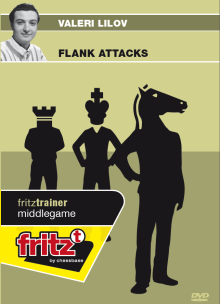 Flank Attacks by
Valeri Lilov
2012
Flank Attacks by
Valeri Lilov
2012
http://www.chessbase.com
E-Mail
info@chessbase.com
Euro 27,90
Pentium-Processor at 300 Mhz or higher, 64 MB RAM, Windows XP, Windows
Vista, Windows 7, DVD drive, mouse, soundcard.
Valeri Lilov handles on his latest DVD all kind of flank attacks, as we
for example can see in the following game from
Alekhine: Alekhine,Alexander - Teichmann,Richard [C83]
Berlin m Berlin (4), 1921
1.e4 e5 2.Nf3 Nc6 3.Bb5 a6 4.Ba4 Nf6 5.0-0 Nxe4 6.d4 b5 7.Bb3 d5 8.dxe5
Be6 9.c3 Be7 10.Be3 0-0 11.Nbd2 Bg4
12.Nxe4 dxe4 13.Qd5 Qxd5 14.Bxd5 exf3 15.Bxc6 fxg2 16.Kxg2 Rad8 17.a4
f6 18.axb5 axb5 19.Bxb5 fxe5
20.Bc4+ Kh8 21.f3 Bh5 22.Ra5 Rd1 23.Bd5 Rxf1 24.Kxf1 Bxf3 25.Bxf3 Rxf3+
26.Ke2 Rf8 27.Kd3 Kg8
28.Ke4 Rb8 29.b4 Kf7 30.b5 Ke6 31.c4 Kd7 32.Ra7 Bd6 33.Kd5 e4 34.b6 Rf8
35.c5 Rf5+ 36.Kc4 1-0, with 27.Kd3
white brings his plus pawn into action.The whole ending is remarkable
easy to win.
A other model game comes from the great Tal: Tal,Mihail -
Najdorf,Miguel [B82]
Chess Olympiad (Men) final-A Leipzig (6), 02.11.1960
1.e4 c5 2.Nf3 d6 3.d4 cxd4 4.Nxd4 Nf6 5.Nc3 e6 6.Be3 a6 7.f4 b5 8.Qf3
Bb7 9.Bd3 Nbd7 10.0-0 Be7
11.a3 0-0 12.Qh3 Qc7 13.Rae1 Nc5 14.Bf2 d5 15.exd5 Nxd3 16.cxd3 Bxd5
17.Nxd5 exd5 18.Nf5 Bc5
19.d4 Ba7 20.Bh4 Ne4 21.Rxe4 dxe4 22.Bf6 Qb6 23.Bxg7 Rfe8 24.Be5 Qg6
25.Nh6+ Kf8 26.f5 1-0.
Flank attacks must be and Lilov offers the reader on this DVD to get in
touch with this useful strategy.
Specially with the role of the centre during a flank attack and the
typical patterns that belong to it.
Running time is four hours.
Conclusion: Enjoyable to study
strategy DVD!
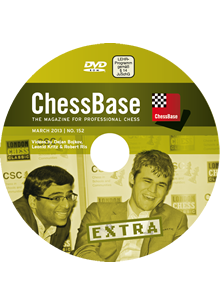 ChessBase Magazine
extra issue 152
ChessBase Magazine
extra issue 152
March 2013
Videos by Andrian Mihalchishin,Leonid Kritz &
Lawrence Trent
ChessBase
http://www.chessbase.com
E-Mail
info@chessbase.com
ISSN 1432-8992
Euro 12.99
This ChessBase Magazine carries over 18.000 games,excatly counted 18433
games where 1621 of them come from the latest Turkish Championship.
All played between December 2012 and February 2013.
In these list you will find fascinating games and rare openings lines
as the Latvian Gambit:
Saez Gabikagogeaskoa,Oscar (1974) - Wu Martin,Eneko (2087) [C40]
Erandio op 21st Erandio (7), 29.12.2012
1.e4 e5 2.Nf3 f5 3.Nxe5 Qf6 4.d4 d6 5.Nc4 fxe4 6.Nc3 Qf7 7.Be2 Nf6
8.0-0 Be6 9.b3 Nbd7 10.Na5 Rb8
11.f3 exf3 12.Bxf3 d5 13.a3 Bd6 14.Nb5 0-0 15.Nxd6 cxd6 16.Qe2 Ne4
17.Bb2 Qg6 18.Rfe1 Ndf6
19.c4 Ng5 20.Kh1 Nfe4 21.Bh5 Qh6 22.cxd5 Bg4 23.Bxg4 Ng3+ 24.Kg1 Nxe2+
25.Rxe2 Qf6 26.Rae1 Qf4
27.Be6+ Kh8 28.Nc4 Nxe6 29.dxe6 Rbe8 30.d5 Re7 31.Ne3 Qe4 32.h3 h5
33.Bc3 b5 34.Bb4 Qe5
35.Rc2 Rf4 36.Bc3 Qg5 37.Bb4 Re4 38.Rce2 Rxe3 39.Rxe3 Qxd5 40.Kh2 Kg8
41.Kh1 g5 42.Kh2 Kf8
43.Kh1 Ke8 44.R1e2 Qd1+ 45.Kh2 Qd4 46.Rf3 Rc7 47.Ref2 Qe5+ 48.g3 Qxe6
49.Bd2 Kd7 50.Bxg5 Kc8
51.Rf6 Qxb3 52.Bf4 Rc2 53.Bxd6 a5 54.h4 b4 55.axb4 axb4 56.Kg2
Rxf2+ 0-1.
Indeed the Latvian Gambit is still alive!
Included are the following video files: Dejan Bojkov who presents
the game Bent Larsen, Larsen-Matanovic, Zagreb 1965,this is a nice
example where a player defends very well for a long time and then
suddenly collapses. Please also see Larsen’s Selected Games of Chess.
Other video files are Leonid Kritz who analyses a famous
Queen's Indian game from the Euwe-Alekhine, revanche match of
1937.
And Robert Ris has deals with the great Rashid Nezhmetdinov.
Conclusion: Must material for a
bargain
price!










